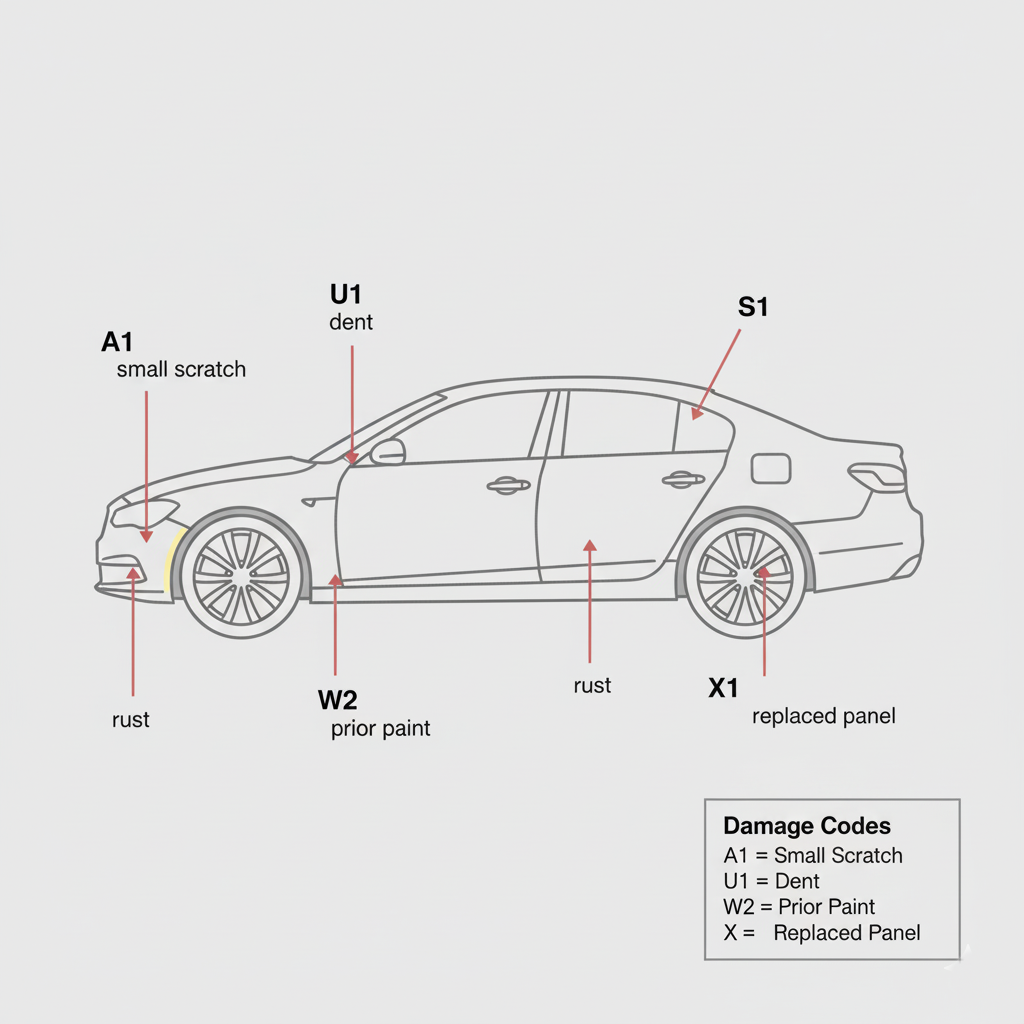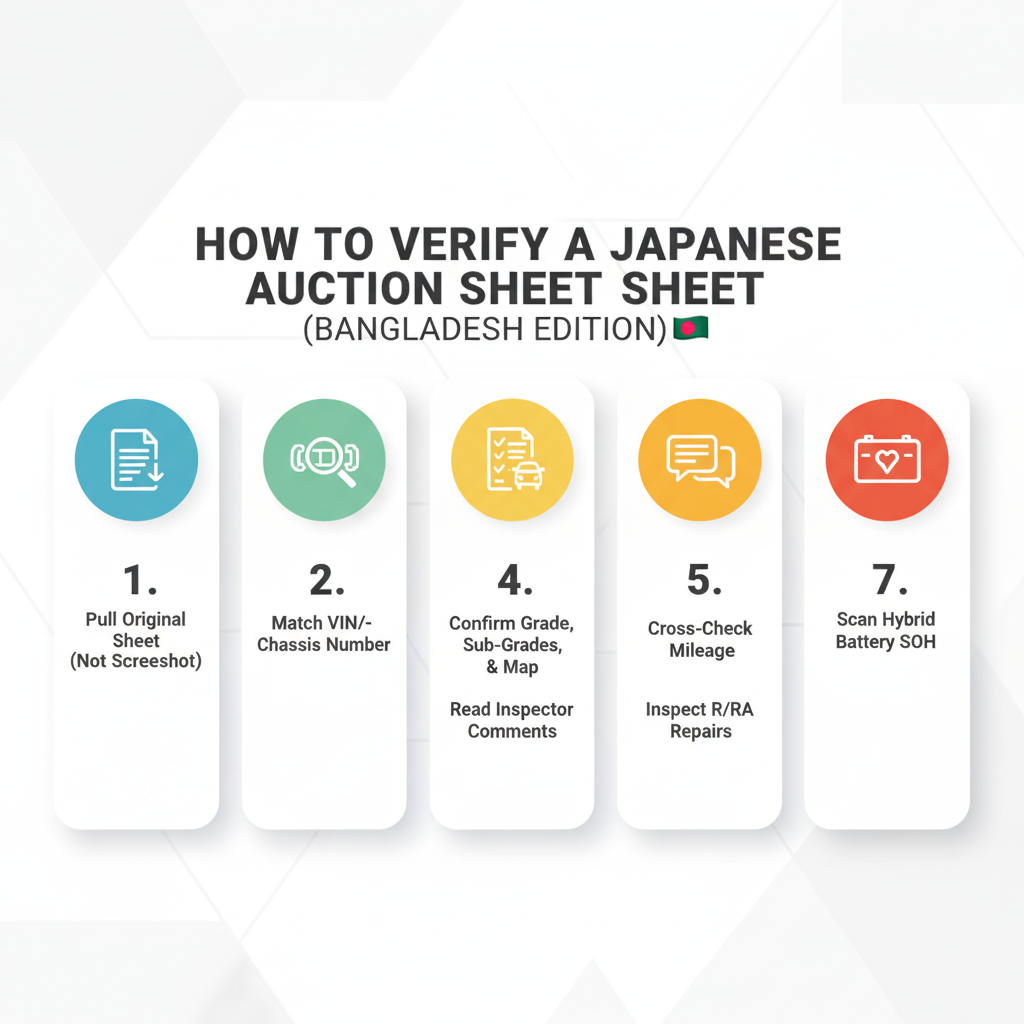Japanese Auction Grades in Bangladesh: No-Nonsense Buyer’s Guide
Read Our Blogs today and Learn More
%20%E2%80%9CAs-New%E2%80%9D%20to%20%E2%80%9CRepaired%E2%80%9D%20for%20Bangladesh%20car%20buyers..png&w=1080&q=75)
Buying a reconditioned Japanese car in Bangladesh should be a smart decision, not a stressful one. Yet one tiny field on a PDF can swing your budget by lakhs: the auction grade. If you’ve ever stared at a sheet with 4.5, 4, or RA and thought, “Okay… but what does that actually mean for me?”, this is your plain-English guide. We’ll decode the numbers (including the less-talked-about 7–9 range some auctions use), unpack the interior/exterior letters, and teach you to read the damage map like a pro. Whether you’ll commute in Dhaka or tour across the country, you’ll learn how to verify, price, and choose the right car, not just the right grade.
What a Japanese auction grade really is (and isn’t)
A Japanese auction grade is an independent condition score assigned by inspectors at large auction houses. The grade summarizes the overall condition at a glance, while the sub-grades (letters) and diagram (damage map) provide crucial details. Think of the number as the headline; the letters and map are the story. When you use all three together, you can predict reconditioning cost, negotiate the right price, and safeguard future resale.
What the grade captures well:
Overall cosmetic and general mechanical condition for its age/mileage.
The kind of surface-level imperfections you’ll likely face on arrival.
What it doesn’t capture fully:
Hybrid/EV battery State of Health, consumables, and deep service history.
The true scope of an accident repair—unless you read the comments and map.
The scale at a glance — including the rarely seen 7–9
Most buyers encounter S / 6 → 5 → 4.5 → 4 → 3.5 / 3 → 2 / 1 / 0, with R/RA denoting repaired/accident history. A few auction houses also use 7, 8, or 9 to signal as-new/delivery-mileage condition—conceptually similar to an “S” at other venues. If you ever see a 7–9 on a Bangladesh-bound car, treat it as exceptional and verify the original sheet immediately (high grade = high stakes).
9 / 8 / 7 (where used): essentially new or delivery-mileage; price and resale behave like “S”.
S: Considered "as new," with both the interior and exterior in flawless condition.
6: Condition also signifies an "almost new" car that is in excellent condition. Age and mileage: The vehicle is usually less than 36 months old and has under 30,000 kilometers.
5: excellent; minimal use; looks and feels very fresh.
4.5: very clean; tiny, localized blemishes are normal.
4: good used condition; typical city rash; strong value tier.
3.5 / 3: average/older; visible wear; plan paint/interior work.
2 / 1 / 0: rough or heavily worn; often for parts/trade buyers.
R / RA: repaired/accident history, buyable if documented, well fixed, and priced right.
Bangladesh reality: For most use cases, a clean 4–4.5 strikes the best balance of purchase price, reconditioning effort, and resale optics. If you’re keeping the car for several years, a well-documented RA can be a smart value, provided structural points and safety systems are clean and the discount is real.
Sub-grades (A–F): why one letter can save—or cost—you money
Auction sheets often assign interior (and sometimes exterior) letters:
A ≈ excellent, B ≈ clean, C ≈ visible wear, D/E/F ≈ heavy wear/defects.
These letters explain why two cars with the same 4.5 might feel different inside, or why a 4 could present better than expected after detailing. They also help you budget in BDT before the car arrives. For example, a 4.5 with Interior C might only need steam cleaning and a minor trim repair; a 4 with Interior A/B could outshine pricier alternatives with minimal prep.
Tip: When comparing close grades, prioritize Interior A/B for daily comfort and resale photos. Buyers react emotionally to cabins; that letter sets their first impression.

The damage map: read A1, U1, W1, S1, and X without guesswork
At the bottom of many sheets sits a tiny car diagram dotted with letters and numbers. It’s not a formality; it’s a repair estimate on a page. Learn these codes and you’ll negotiate like a pro:
A1/A2/A3 — small scratch / scratch / deep scratch
U1/U2/U3/U4 — small dent → larger dents
W1/W2/W3 — prior paint/repair “wave” (finish variance you can see in reflections)
S1/S2 — rust / heavy rust
X / XX — must replace / already replaced panel
Quiet truth: Many buyers obsess over A and U because they pop in photos. But W-codes matter more for resale; they reveal prior paint. A shiny car with W2/W3 on multiple panels can underperform at resale versus a duller car with a few A1s that polish out.
R/RA cars: risk, reward, and the right way to buy them
R/RA doesn’t mean “run” it means “research.” These grades flag accident or repair history. Your job is to judge how much was fixed and how well. Read the inspector comments; look for XX/X on the map; on arrival, have a technician check rails, aprons, and any airbag deployments or module codes. If documentation is strong and the price gap to a non-R car is fair, an RA can be an excellent long-term keeper.
Negotiation lens: You’re trading accident stigma for value. The discount should reflect the quality and scope of repair, plus the likely resale drag later. If it doesn’t, walk.
What grades don’t cover (and how to fill the gaps)
The number is a snapshot, not a diagnostic report. Three gaps matter most in Bangladesh:
Hybrid/EV battery SOH
The grade doesn’t measure battery health. Always run a proper SOH scan (e.g., for Aqua, Prius, Vezel, Serena e-Power). Heat, congestion, and short trips stress weak packs. Don’t guess.Consumables and service history
Tyres, brake pads, and fluids may pass inspection but be near end-of-life. Budget for a sensible arrival service and request any available records.Mileage confidence
The ecosystem discourages tampering, but best practice is to cross-check mileage with any service stickers/books and perform an ECU read where applicable.
How grades affect your total cost in Bangladesh
Instead of thinking “4 vs 4.5,” think “how many panels and hours?” The damage map tells you what to fix; your body shop tells you how much it costs here. A car with scattered A1/U1 may be cheaper to prep than one with multiple W2 panels. Surface scratches often polish out; W-codes typically mean repaint. Rust flags (S1/S2) demand quick attention; delaying can amplify costs in our climate.
A practical way to price the difference:
List the codes by panel (e.g., “W2 RF fender”, “A2 rear door”).
Ask for per-panel quotes and a bundle rate for multi-panel work.
Add realistic interior detailing for C-grade cabins.
Keep a contingency pot for surprises (clips, trims, alignment, minor hardware).
You’ll often find a clean 4 with smart prep can land and present as well as a 4.5, for less. But if you prioritize minimal downtime and the best resale optics, paying for a true 4.5 can still be the winning play.
Choosing by use-case (works across the country)
Daily commuter: Choose 4–4.5 with Interior A/B; accept a couple of A1/U1 marks you’ll smart-repair later. Comfort and cabin condition matter more than chasing a perfect exterior.
Long-distance traveler: Fewer W-codes reduces wind noise and the chance of mismatched panels humming at speed. Consider a 4.5 if you log lots of highway kilometers.
Hybrid city life: Grades don’t reflect battery health—make the SOH scan non-negotiable. A clean 4 becomes a liability if the pack is weak; a well-scored battery makes a 3.5–4 feel like a steal.
Value hunters and keepers: A documented RA can be smart if you’ll keep the car several years. You’re monetizing the stigma into today’s discount while enjoying the same utility.
Seven-step verification (do this before you transfer funds)
Pull the original auction sheet from a reputable source—don’t rely on screenshots or “translated” copies.
Match identifiers: chassis/VIN, lot number, auction name and date must align.
Confirm the trio: overall grade, sub-grades, and damage map should all be present and consistent.
Read comments: inspector notes should agree with the map; contradictions are a red flag.
Cross-check mileage with any service stickers/books and, when possible, ECU records.
R/RA diligence: plan a structural/safety inspection on arrival; check rails/aprons/seams and run an SRS/airbag diagnostic.
Hybrids/EVs: perform a battery SOH scan; don’t accept guesses or generic claims.

Keep a proof trail (original file, lookup ID, and your notes). It helps when you resell and protects you if disputes arise.
About those 7–9 cars (the “S-plus” conversation)
Some auction houses extend above “S/6” with 7, 8, and 9 to capture cars that are basically showroom new delivery mileage, first plate, or immediately post-registration. On paper, they’re unicorns, and on price they behave that way too. If someone offers you a 7–9, your move is simple: independent original-sheet retrieval and intense scrutiny of dates, lot numbers, and any photos. When the grade is that high, a forged sheet is the real risk, not the car.
Key takeaways (clip & save)
The number is the headline; letters + map are the story.
W-codes (prior paint) weigh more on resale than small A/U marks.
R/RA can be a win with proof, quality repair, and correct pricing.
Grades don’t include hybrid/EV battery health—scan SOH.
Always verify originals, match identities, and keep a proof trail.
Why choose Carbarn Bangladesh
When a single digit can swing your car’s value by several lakhs, you don’t need hype, you need clarity. That’s the Carbarn Bangladesh way. We replace guesswork with verified documentation, retrieving original Japanese auction records, matching identities, and flagging inconsistencies before you commit. Every report is transparent, not dressed up in buzzwords, a plain-English breakdown that connects the auction grade, inspection notes, and damage map to a realistic preparation plan for Bangladesh roads.
For hybrids and EVs, Carbarn Bangladesh goes the extra mile with detailed battery SOH scans, explaining exactly what the numbers mean for daily driving and long-term resale value. Our costing approach respects your wallet, reflecting real-world parts and labor prices so you can decide confidently when a Grade 4 makes more sense than paying a premium for a 4.5, and when it doesn’t. Even after purchase, the guidance continues. From first inspection to first service, Carbarn Bangladesh stays by your side with honest, practical advice, ensuring your car feels like a smart investment, not a gamble.
Frequently Asked Questions (FAQs)

Arif Hasnat
Car Specialist & Data Analyst
Arif Hasnat is a Car Specialist and Data-Driven Analyst at Carbarn, where he bridges marketing, data, and engineering to optimize performance across international automotive markets. Skilled in Python automation, machine learning, QA testing, and technical SEO, he uncovers actionable insights from large datasets to enhance visibility, efficiency, and growth.
Published Date
November 12, 2025